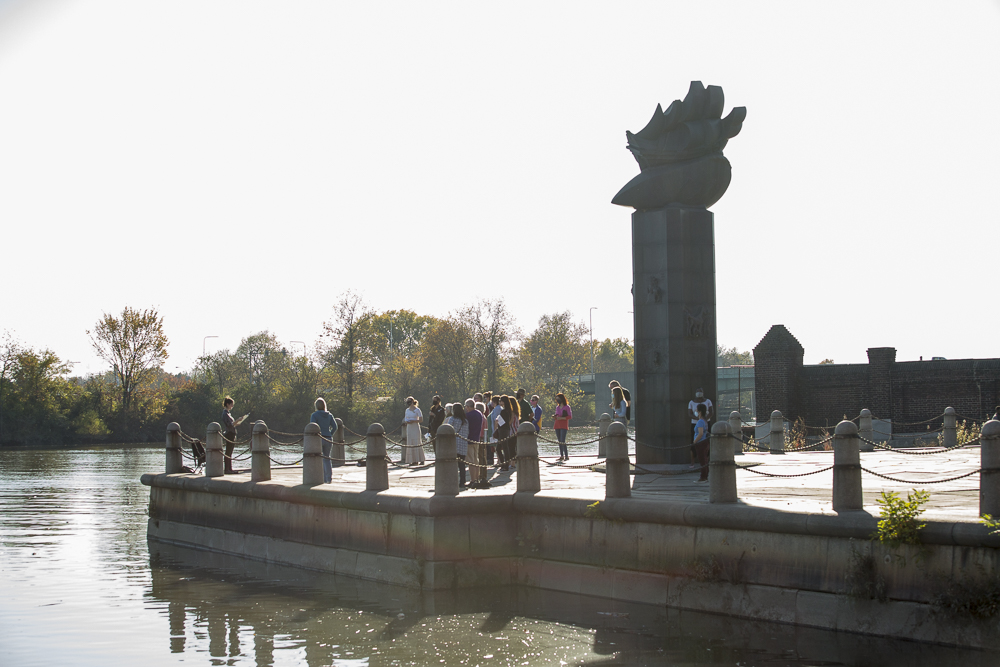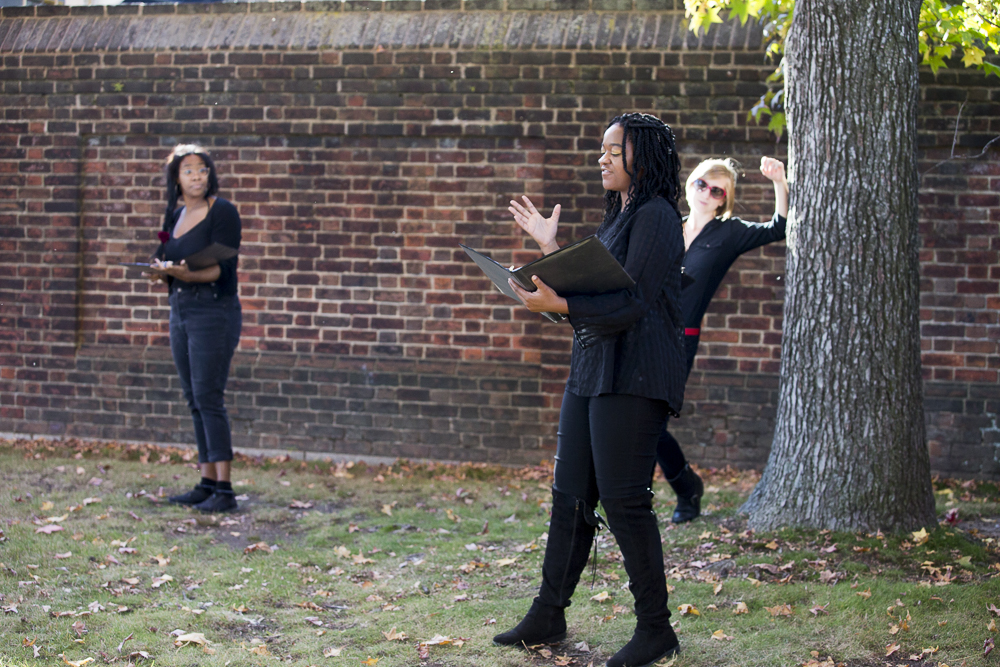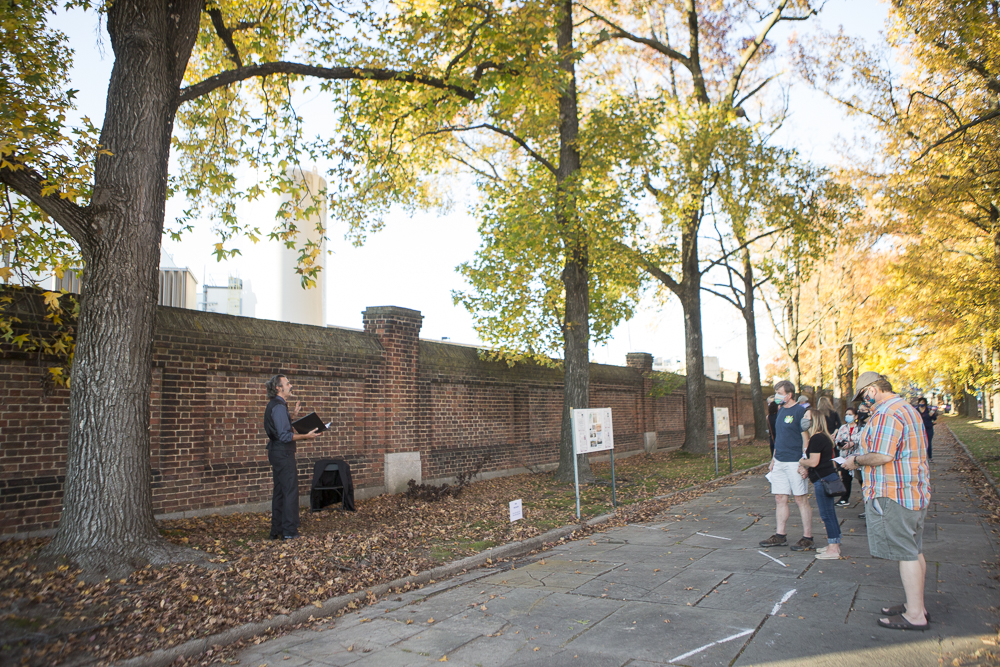by Christian Wills, Arts Journalist-in-Residence
Performing arts and Mother Nature go together like cheese crackers and fine wine. Throughout history, many have seen countless outdoor plays; be it on college campuses or outdoor arenas. Many can be seen from up close or in your neighbor’s backyard. For Del Shakes, a similar, yet unique experience was found at a historic site, hidden deep in Wilmington’s Eastside area.

Description of Event
On the eve of November 1st, Delaware Shakespeare hosted an outdoor performing arts event entitled Shakespeare, Poe & Fiends. The event was directed and compiled by Matthew Mastronardi and held at Fort Christina Park. The compilation consisted of different performing actors and actresses portraying different Shakespearean-esque stories. Audience members were able to scatter around the park to see each story of their choosing while taking in the scenery of the park itself. After being checked in, attendees were able to take in the wealth of options available to them, amid the beauty of nature and historical sights.
Fort Christina
Fort Christina was the first North American Swedish settlement, built in 1638 and named after Queen Christina of Sweden. The site is currently located east of present-day downtown Wilmington, Delaware, neighboring the Christina River. Fort Christina was declared a National Historic Landmark in 1961 and later became part of the First State National Historic Park in 2016.
Residing as a Delawarean for the past five years, Fort Christina has escaped my knowledge up until today. Walking through the park, you can absolutely feel the historic energy or “vibe” in the air. The path on the trail contains trees toward the sides of the walls and in the middle of the large median of grass. Beneath the trees are two lanes of open space, creating the trail of bricks that lead toward the pier and open river. The trail ends with a giant statue, representing the Fort Christina Monument; a tall pillar erecting and replicating the Swedish ship, Kalmar Nyckel. Seeing these magnificent sights amazed my eyes and mind with delight as the event pushed on through the evening.

A and B Stories
Poe and Fiends offered a selection of six different stories to choose from; the first three stories were called “A Stories” and the other half were labeled “B Stories.” Each story had a different location placed within the park for viewers to watch. “A Stories” and “B Stories” were listed to go on fifteen minutes apart from each other, giving audience members time to view each one in an order they desired.
The three “A Stories” were the first performances to top off the afternoon park event. Within order, the first one listed was “The White Deer,” a traditional Lenape tale told by Grant Youngblood. The second “A Story” was “The Masque of the Red Death,” written by Edgar Allan Poe and read by Cassandra Alexander, Adaeze Nwoko, and Natajia Sconiers. The last “A Story” was “Näcken,” a Swedish folktale by Verner von Heidenstam, read and co-adapted by Emily Schuman.
The three “B Stories” were played simultaneously after the “A Stories” were shortly conducted. Within order, the first “B Story” was “Our Efficient Plot,” a local oral history from the Underground Railroad, read and co-adapted by Newton Buchanan. The second was “The Raven,” by Edgar Allan Poe, read by Gregory Isaac. And lastly, “Macbeth” Act 1, Scene 5 and 7, was read by Minou Pourshariarti and Steve Wei.

My Experience
When I arrived at Fort Christina, my first stop led me to Youngblood and his reading of “The White Deer,” located by the entrance of the park. He was gearing himself for the new crowd that had formed; holding his binder in one hand and waving with the other to acknowledge the incoming mass of participants. Soon, he began to read the old Lenape tribe story. My mind had drifted deep into the page and within the world as the Native folklore kept the audience on their toes. “The White Deer” was excellent in representing non-traditional stories and story-telling, all while projecting the shared history of the Lenape tribe and their significance in Delaware. I could see the reception from the audience, as they applauded and cheered with appreciation.
Afterwards, I had traveled down the walk way and through the large medium of grass and trees to find the powerful couple, Pourshariati and Wei, playing as Lady Macbeth and Macbeth, respectively. Many participants that came to see were enamored with the duo’s performance.

As the hour passed on, audience members passed by and indulged in more stories before the night could fall. I found myself transfixed by the Swedish story of a naked water monster, the “Näcken,” told by Schuman while next to the Christina River. Surrounded by the Fort Christina monument, audience members spread out under the river’s sky to hear the wretched depiction of the Näcken.
Soon after, I would hear the song and sweet singing to freedom in Buchanan’s depiction of “Our Efficient Pilot,” a slave’s tale filled with journeys and expeditions to a better tomorrow. This story spoke to me personally as a person of color and resident of Delaware. The story gave justice to those who escaped freedom alongside Harriet Tubman across the Delaware and people of color living today in every corner of Wilmington. It amazed me and many others that discovered how important Fort Christina was to those wanting to seek a better life.
Around the bend, I caught wind of the story “The Masque of Red Death” and its eerie similarities to a plague familiar to our own in 2020. The main cast of female readers and performers stuck many in amazement with audience members, especially for women of color and young girls that enjoyed the show. My journey, however, profoundly came to a standstill with Isaac’s reading of “The Raven,” closing out my rounds and personal adventure at the park. The story was a perfect way to end off the overall experience and reflect on what I had just seen.

Social Distancing and COVID Concerns
Concerns for others to practice social distancing were addressed through the subtle procedures. Markings on the ground were used to separate the audience from the readers and performers. Many of the readers themselves were spaced out carefully with social distancing in mind. Viewers watching would space themselves from others while standing and staff on site would wear masks and “bump arms” with attendees if they wanted to greet you properly.
My Closing Thoughts
Reflecting more on the event in question, I believe that the “choose your own adventure” format helped to provide an experience unique to the individual. This approach gives people the freedom of choice and range in flexibility when selecting a single story. Seeing the stories rotate as you move from one part of the park to another evokes a child-like wonder, similar to “movie-hopping” within a theatre. The atmosphere of an autumn evening among fallen leaves and soft soil can warm any poetry enthusiast as they listen to their favorite story. Delaware Shakespeare has shown us again how to make a fun, adventurous experience in times where we need them the most.





